How to connect the Internet to a computer from a router. How to connect wired internet via wifi router?
In this instruction - step by step on what to do if the Internet does not work on a computer with Windows 10, 8 and Windows 7 in various scenarios: the Internet disappeared and stopped connecting for no reason via the provider's cable or through a router, only stopped working in the browser or certain programs, works on the old one, but does not work on the new computer and in other situations.
Note: In my experience, in about 5 percent of cases (and this is not so few) the reason why the Internet suddenly stopped working with the message “Not connected. No available connections"In the notification area and" Network cable not connected "in the list of connections indicates that the LAN cable is really not connected: check and reconnect (even if visually it seems that there are no problems) the cable both from the side of the computer's network card connector and from side of the LAN connector on the router if you are connecting through it.
The Internet is not only in the browser
I'll start with one of the most common cases: the Internet does not work in the browser, but Skype and other instant messengers, torrent clients continue to connect to the Internet, Windows can check for updates.
Usually, in such a situation, the connection icon in the notification area indicates that Internet access is available, although in fact this is not the case.
The reasons in this case may be unwanted programs on the computer, changed settings. network connections, problems with DNS servers, sometimes - incorrectly removed antivirus or Windows update("Big update" in Windows 10 terminology) with antivirus installed.
I considered this situation in detail in a separate guide: it describes in detail the ways to fix the problem.
Checking the network connection over a local area network (Ethernet)
If the first option does not suit your situation, then I recommend following these steps to test your Internet connection:

Let's dwell on point 6 - connection by local network shows that everything is fine (enabled, there is a network name), but there is no Internet (this may be accompanied by the message "No Internet access" and yellow Exclamation point next to the connection icon in the notification area).
LAN connection is active, but there is no Internet (no Internet access)
In a situation where the cable connection works, but there is no Internet, several common causes of the problem are possible:
- If the connection is via a router: there is something wrong with the cable in the WAN (Internet) port on the router. Check all cable connections.
- Also, for a situation with a router: the Internet connection settings on the router are lost, check (see). Even if the settings are correct, check the connection status in the web interface of the router (if not active, then for some reason the connection cannot be established, perhaps the 3rd point is to blame).
- Temporary lack of access to the Internet from the provider - this does not happen often, but it does happen. In this case, the Internet will not be available on other devices through the same network (check if possible), usually the problem is fixed within a day.
- Problems with network connection settings (DNS access, proxy settings, TCP / IP settings). The solutions for this case are described in the article mentioned above and in a separate material.
For the 4th step of those actions that you can try first:
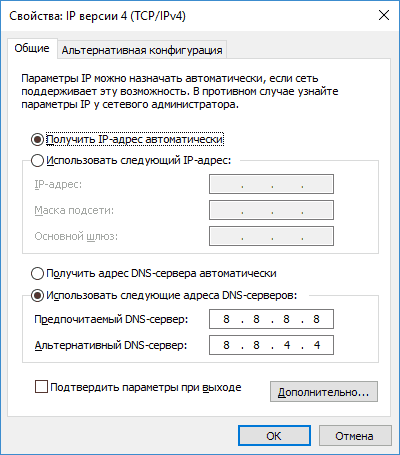
If these two methods do not help, try the more sophisticated methods of solving the problem from the separate instructions given in the 4th paragraph above.
Note: if you have just installed the router, connected it with a cable to your computer and there is no Internet on the computer, then most likely you have simply not configured your router correctly yet. Once this is done, the Internet should be up and running.
Computer network card drivers and disabling LAN in BIOS
If the Internet problem appears after reinstall Windows 10, 8 or Windows 7, as well as in cases where there is no local network connection in the list of network connections, the problem is most likely caused by not installed required drivers network card. Less often - by the fact that the Ethernet adapter is disabled in the BIOS (UEFI) of the computer.
In this case, follow these steps:
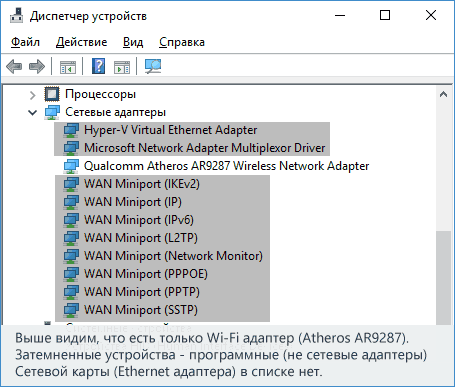
Perhaps, in this context, it will be useful: (if there are unknown devices in the list in the task manager).
Network card parameters in BIOS (UEFI)
Sometimes it may turn out that network adapter disabled in BIOS. In this case, you will definitely not see network cards in Device Manager, and LAN connections in the list of connections.
The parameters of the computer's built-in network card can be located in different sections of the BIOS, the task is to find and enable it (set the value to Enabled). Here can help: (relevant for other systems).

Typical sections of the BIOS, where the desired item may be located:
- Advanced - Hardware
- Integrated peripherals
- On-board device configuration
If the adapter is disabled in one of these or similar LAN sections (it may be called Ethernet, NIC), try to enable it, save the settings and restart the computer.
Additional Information
If by the current moment to figure out why the Internet has not been working, as well as to make it work, the following information may be useful:
- On Windows, Control Panel - Troubleshoot has a tool to automatically fix Internet connection problems. If it does not correct the situation, but provides a description of the problem, try searching the Internet for the text of the problem. One of the common cases:.
- If you have Windows 10, check out the following two things that might work :,.
- If you have new computer or motherboard, and the provider restricts access to the Internet by MAC address, then you should inform him of the new MAC address.
I hope that some of the options for solving the problem with the Internet on a computer via a cable came up for your case. If not, describe the situation in the comments, I will try to help.
The question of how to connect wifi router to a computer, users are asked when they want to use the Internet throughout the apartment and have free access to wifi network from multiple devices. In addition, they are interested in how many computers can be connected.
Installing and connecting a router is a simple process, which, however, requires careful adherence to the algorithm of actions.
Installing the router
Router installation can be done in two ways:
- on wireless network;
- using a twisted pair (special wire, which usually comes with the device).
The second method is less preferable. In order to make a connection, three main components are needed:
- The actual wi-fi router;
- Stationary computer or laptop with an installed network card;
- Network cable.
If you only need a wi-fi router to use the Internet from your phone or tablet at home, then inexpensive router models designed for 4-6 devices are quite suitable for you.
However, still pay attention to how many computers can be connected to the network at the same time.
Advice! Special requirements for the device should be presented in the event that you plan to store data. Also, when choosing, it is worth clarifying what speeds the device supports, they must be gigabytes. Otherwise, working on the Internet will become very difficult.
Wired connection
It is quite simple to connect a router using a twisted pair cable, however, this connection greatly complicates its operation.
In particular, you will not be able to move away from the computer more than a certain distance. Therefore, this option is not applicable for laptops. But it can be a good solution if you have stationary computer.
Has such a wi-fi connection and pluses. For example, it is believed that in this way the Internet gives less disruption to work.
- First, connect the internet cable to the router.
Locate the WAN port on the back of the product and plug the cable into it. Then take the network wire and connect it to the router to the Ethernet port, and the other end to the corresponding port on the computer.
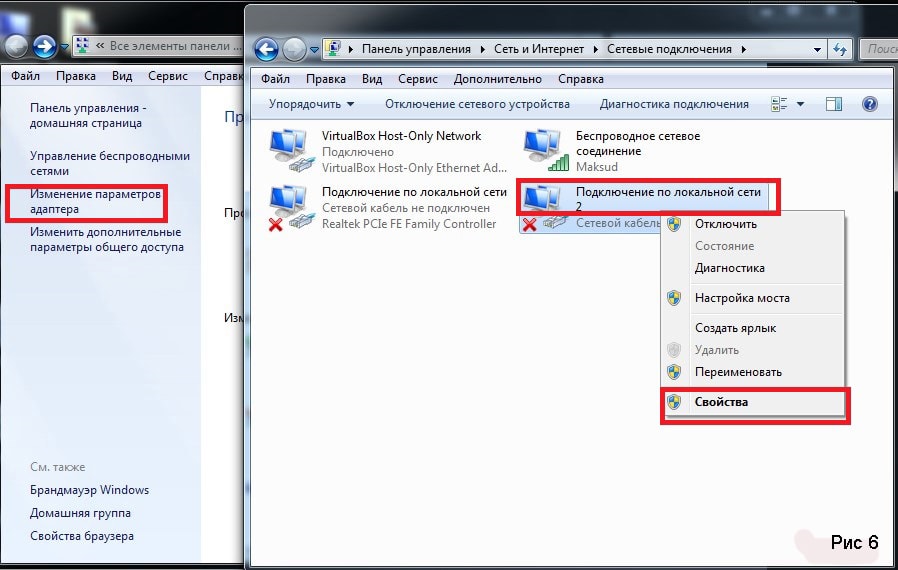
- Set up your router.
Open any browser and enter the IP address of the device in the address bar. The address must be in the format. The true IP of the router can be viewed on a sticker on its bottom or in the technical documentation for the equipment.
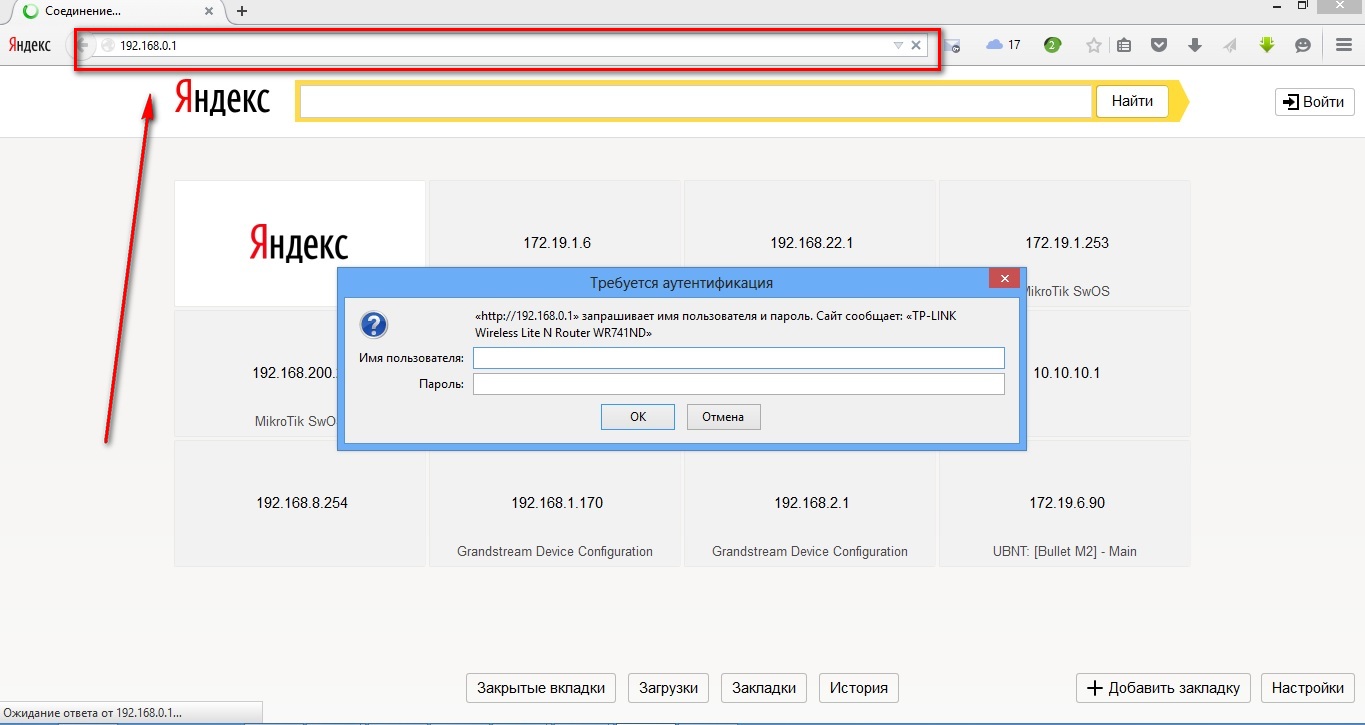
After the IP is registered, the setup program will require you to enter your username and password. Then you can change the password for convenience. After that, the main menu of the wired network settings opens.
Important! If you are using a wired connection, then pay attention to the number of connectors in the router. How many of them - how many computers you can connect to the device.
Wireless connection
If you intend to connect a wi-fi router wirelessly, then you will have to configure the connection in two stages. The first of them is the actual settings, and the second is the work on network security.
- In the router menu, open the "Wi-Fi" tab, and there find a tab named " Manual setting parameters ". The names of the tabs may differ depending on the type of router, but their meaning is usually obvious.

- In the main settings, we find the SSID field. In it we write the name of the network. This is the name that you will see, connect the Internet from any device. Set the correct region in which the wi-fi network will work.
Next, you need to select a channel for data transmission. It is better to leave the one that was specified initially. However, over time, it can be changed if problems arise with access to the Internet.

- Choose wi-fi standards. It is advisable to leave mixed at the default. Now choose how many network users will be able to connect multiple computers to it at the same time.
If the number of users should not be limited, select "0".

- Go to the "Security" or "Security Settings" tab. In the field above, select the type of protection. WPA2-PSK will do. Write down the password in the "Key" field. Such measures will protect you from hacking and from those who like to use the Internet at someone else's expense.
Only someone who knows the password can connect the device to the network.
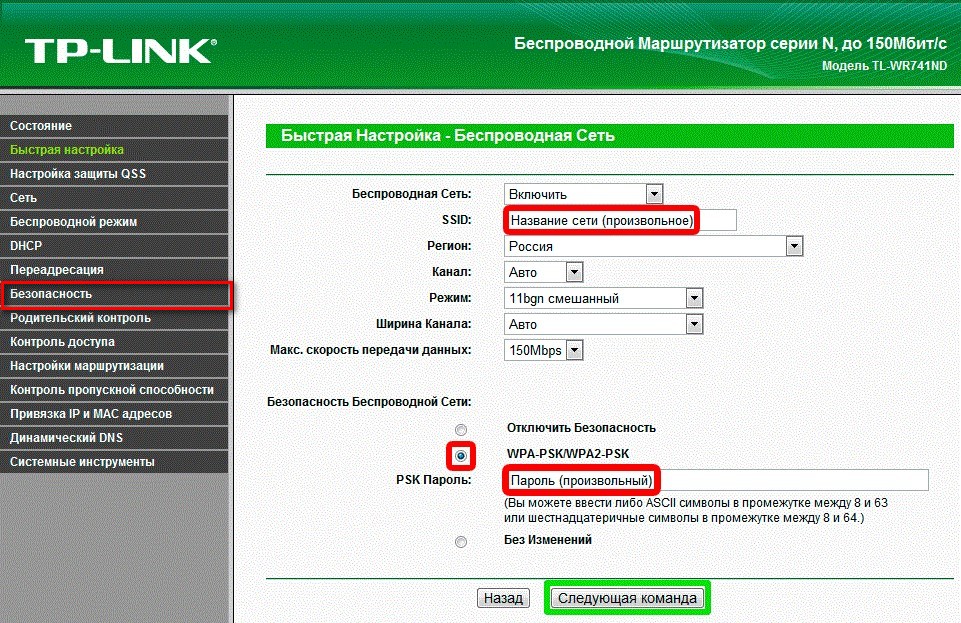
The advantage of this method is that you can use the Internet throughout the apartment. And, besides, only with this type of network it is possible to connect a second, third or more computers that are far from the device.
The question of how to connect a wi-fi router to a computer, users are asked when they want to use the Internet throughout the apartment and have free access to the wi-fi network from several devices. In addition, they are interested in how many computers can be connected.
Installing and connecting a router is a simple process, which, however, requires careful adherence to the algorithm of actions.
Installing the router
Router installation can be done in two ways:
- wirelessly;
- using a twisted pair (special wire, which usually comes with the device).
The second method is less preferable. In order to make a connection, three main components are needed:
- The actual wi-fi router;
- Stationary computer or laptop with an installed network card;
- Network cable.
Before buying a router, it is recommended to study the parameters of your own computers and other devices, since not all routers are compatible with all computers. Moreover, the older the laptop and / or software, the more difficult it is to find a compatible router.
ASUS routers are considered one of the most versatile. ZyXEL also has good characteristics. Also check the signal range of the device before purchasing.
If you only need a wi-fi router to use the Internet from your phone or tablet at home, then inexpensive router models designed for 4-6 devices are quite suitable for you.
However, still pay attention to how many computers can be connected to the network at the same time.
Advice! Special requirements for the device should be presented in the event that you plan to create a powerful local home network for data storage. Also, when choosing, it is worth clarifying what speeds the device supports, they must be gigabytes. Otherwise, working on the Internet will become very difficult.
Wired connection
It is quite simple to connect a router using a twisted pair cable, however, this connection greatly complicates its operation.
In particular, you will not be able to move away from the computer more than a certain distance. Therefore, this option is not applicable for laptops. But it can be a good solution if you have a stationary computer.
Has such a wi-fi connection and pluses. For example, it is believed that in this way the Internet gives less disruption to work.
- First, connect the internet cable to the router.
Locate the WAN port on the back of the product and plug the cable into it. Then take the network wire and connect it to the router to the Ethernet port, and the other end to the corresponding port on the computer.
- Set up your router.
Open any browser and enter the IP address of the device in the address bar. The address must be in the format http://192.168.0.1/. The true IP of the router can be viewed on a sticker on its bottom or in the technical documentation for the equipment.
After the IP is registered, the setup program will require you to enter your username and password. Then you can change the password for convenience. After that, the main menu of the wired network settings opens.
Important! If you are using a wired connection, then pay attention to the number of connectors in the router. How many of them - how many computers you can connect to the device.
Wireless connection
If you intend to connect a wi-fi router wirelessly, then you will have to configure the connection in two stages. The first of them is the actual settings, and the second is the work on network security.
- In the router's menu, open the "Wi-Fi" tab, and there find a tab called "Manual settings". The names of the tabs may differ depending on the type of router, but their meaning is usually obvious.
We register the name of the network
- Choose wi-fi standards. It is advisable to leave mixed at the default. Now choose how many network users will be able to connect multiple computers to it at the same time.
If the number of users should not be limited, select "0".
- Go to the "Security" or "Security Settings" tab. In the field above, select the type of protection. WPA2-PSK will do. Write down the password in the "Key" field. Such measures will protect you from hacking and from those who like to use the Internet at someone else's expense.
Only someone who knows the password can connect the device to the network.
The advantage of this method is that you can use the Internet throughout the apartment. And, besides, only with this type of network it is possible to connect a second, third or more computers that are far from the device.
Connecting a wired network is a little easier, it requires not so much additional work with security parameters as entering data that is not always at hand. Go to the "Network" tab in the router menu, and from there to the "Connections" tab.
Fill in the empty fields, if any. If all fields are filled in, confirm your choice.
Go to the "IP Settings" tab. Here you need to specify LAN network address and the subnet mask. These data must be specified in the contract for the provision of services by the provider. However, sometimes these data are not indicated. In this case, you can call the provider's customer support.
There you will be required to provide this information. Confirm your choice by clicking the "Save" or "OK" button.
A wired network, although more secure, is not very convenient and does not provide an opportunity to connect the Internet to a second or even several computers. However, the choice of the type of connection depends solely on the needs of the user.
How to connect a router to a computer
In order to connect the router to the computer, you need to connect the blue cable to one of the four blue sections. In the computer settings, the connection is configured in the Network and Sharing Center.
In this series of articles, you will learn how to create a small network of several computers in your home, as well as connect your laptop to the Internet via a wi-fi connection.
In order to carry out all the above operations, we need such a cunning device as a router. In order not to use any complicated terms and confusing explanations here, I will say in simple words: A router is actually a dividing box, thanks to which you can connect about 4 computers via cable and many computers via wireless connection.
That is, the provider leads us only one cable to the apartment and, of course, we can connect only one computer if we do not use a router.
The most popular today are D-Link routers. It is on the example of a router of this company that I will show how to perform further actions.
If you print the box, then the kit should include: the router itself, a power supply, a cable with two RJ-45 plugs, instructions for use and an installation disc.
Installation disc you hardly need because it's better to configure everything manually.
Let's now look at the D-Link Dir-300 router itself. Pay attention to the ports:
INTERNET is an entrance for a cable that was handed to you by the employees of the provider company.
LAN 1,2,3,4 - inputs for connecting computers. As you can see, the maximum number is 4 pieces.
5V ---- 1.2A - to connect the power supply.
RESET is a small button that can be pressed with a pen or a match. Reset or reboot button. Resets all the settings that you have set and sets the default settings. A very convenient button when you forget the password for the router, because when you press the button, it is reset along with the rest of the settings.
How do I reset the router settings? In order to reset the password and router settings, you just need to hold the RESET button with a match and hold it for a little more than 5 seconds. Then wait until the router reboots, and the lights on the front panel will start blinking again, as if nothing had happened.
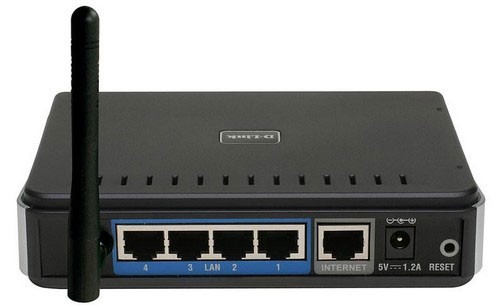
The router can be hung somewhere in the corridor so that it does not interfere. There should be a 220V socket nearby so that the power supply can be reached.
Before configuring the router, you must inform your provider about the MAC address of the router. It is written on the back on a white sticker. In other matters, you can read the instructions for it where you can see the MAC address of a particular router. Most ISPs require you to report router addresses over the phone, just like the physical addresses of your computers' network cards. The operator will have to register the router on the network in order for the router with this address to access the Internet through this provider.
Let's take a photo consider how a laptop is connected to a router via a cable.
We fix the router on the wall and connect it to the power supply and insert the cable that the provider let you down into the INTERNET port.
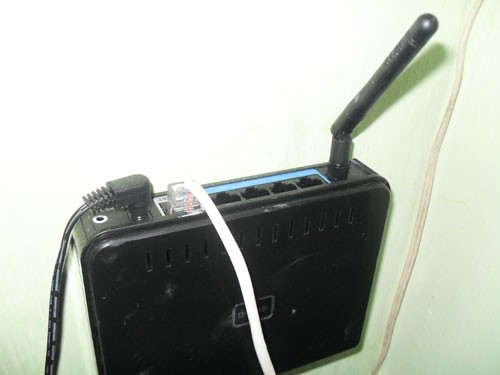
We connect network cable into the corresponding connector on the laptop and connect it to one of the LAN connectors of the router.

Correctly connected router as follows:
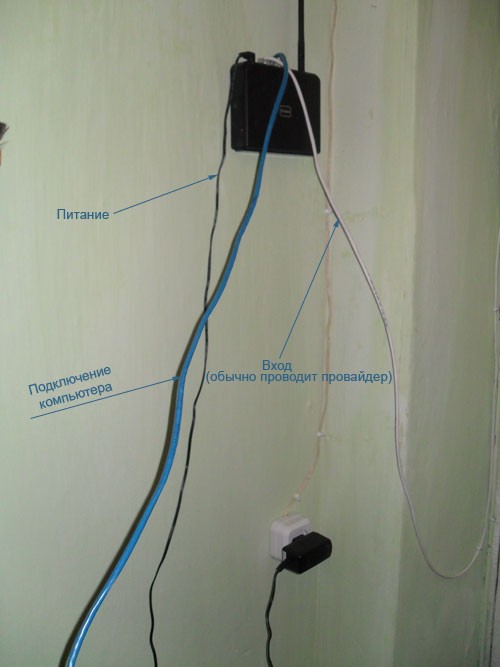
If you just connect all the cables, then the Internet will not work, the router needs to be configured. In the same way, create a connection to the Internet, as in the case of a computer, in the same way enter your username and password into the router interface so that the provider will let you on the Internet.
In one of the previous articles, we looked at a very topical issue. Here we will present the opposite situation: how to connect wired Internet, if there is wifi router.
How to connect wired internet from a router?
And first of all, consider how. The placement of the router depends on how often you plan to use it: if you just need a Wi Fi access point (i.e. you will not connect anything to it via LAN), then it is advisable to fix the router somewhere upstairs in the middle of the apartment.
If you are going to connect the wired Internet from the router to a computer or laptop, then you will have to pull the network cable into the room where the computer is installed.
Now let's consider directly connecting a Wi Fi router. Within the framework of this example a TP-Link router is used.
So, to connect the Internet (wired) through a router, turn the device towards you with the side where the LAN ports are.

This router has five LAN connectors: four yellow ports and one blue connector. The yellow ports are needed to connect hardware (such as computers, NAS servers, etc.), and the blue port is needed to connect to the wired Internet - it's called "Internet" or "WAN".
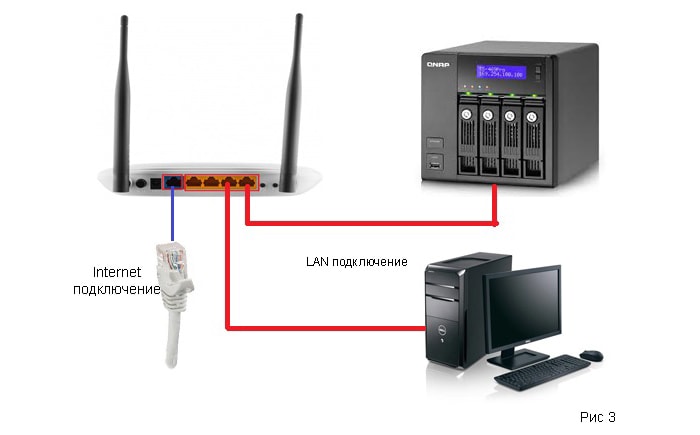
Take the provider's cable and connect it to the blue WAN port: this should light up the light on the front wifi panels router.
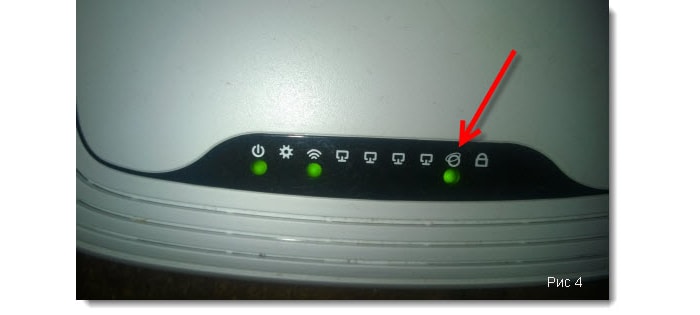
This means that the wired Internet from the ISP is successfully fed to the router.
It is advisable to check the network settings on the computer - if it will be used in the future. To do this, go to the "Start" menu, go to the "Control Panel" tab and click on the "Network and Access Center"
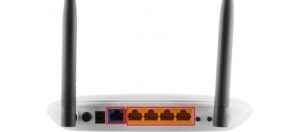
A window will open where in the upper left corner there will be a tab "Changing adapter parameters": click on it, select your LAN connection and go to the properties of this connection.

In the next window, you should find the "Internet Protocol version 4 (TCP / IPv4)" tab in the list of settings, go there and make sure that the checkboxes are checked on the "Obtain an IP address automatically" tab
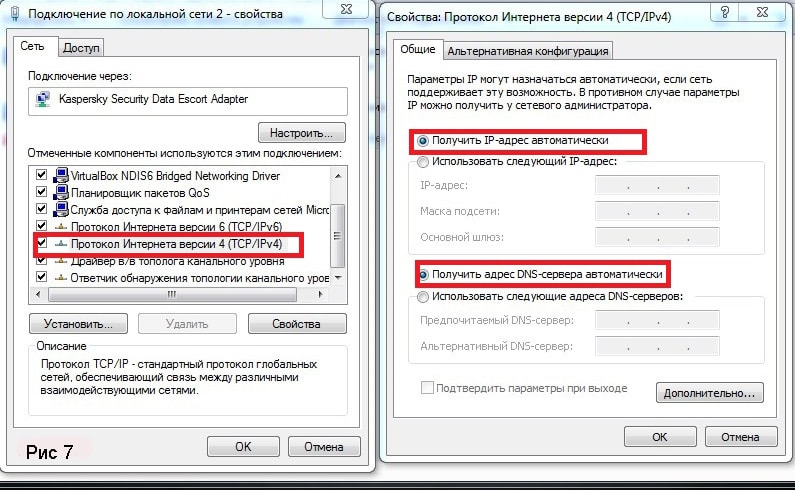
Now let's move on to wifi setting router for connecting wired Internet.
How to connect cable Internet through a router: configuring the router
Launch an internet browser and in address bar enter the IP address of your router (depending on the model, the IP addresses may differ, but mostly it is 192.168.0.1, less often 192.168.1.1).
If everything is done correctly, an authorization window will appear.

Now you need to enter your login and password to enter the router settings (in standard configurations this is the word "admin", which is entered in both fields).
After authorization, you will see the control panel for your wifi router (depending on the router model appearance may differ slightly).

Go to the "Quick Settings" tab and click the "Next" button
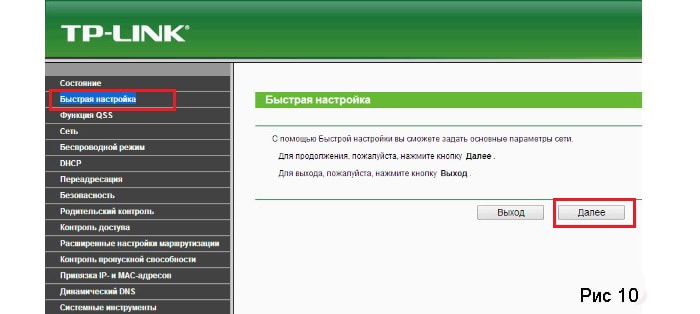
Here are several options for connecting to the Internet:
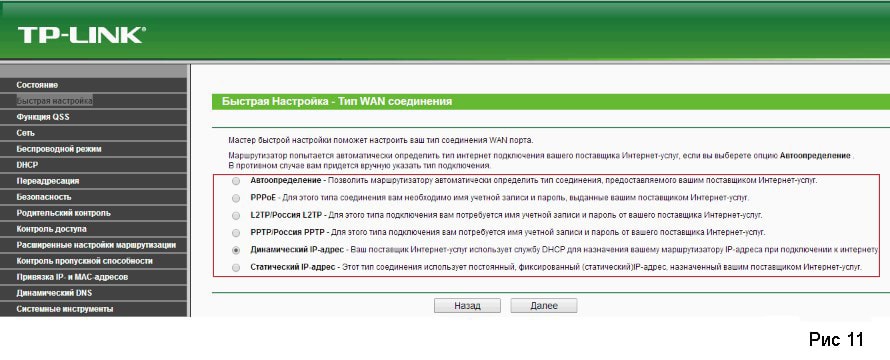
Let's get acquainted with this item in more detail:
- - Auto detect - as the name suggests, this connection automatically configures your router and is often used in the absence of settings from the provider.
- - PPPoE - when you select this item, an additional window will open where you should enter the password and login provided by your Internet provider.

L2TP / Russia / L2TP - just like for PPPoE connection, you will need to fill in the authorization fields, as well as enter the server name or its IP

PPTP / Russia / PPTP - almost identical to the previous connection option, except for specifying the type of IP address

- - Dynamic IP address - each time the client connects to the Internet, the client receives a new IP address from the range specified by the provider.
- - Static IP address - permanent address used to connect to the Internet.
There is wired internet, how to connect wifi?
Now you need to set up a Wi Fi connection. To do this, go to the next tab and in the "Wireless mode" field set the marker to "Enable".
In the "Wireless network name" field, enter the name you like best, check the "WPA, Personal WPA2" box (this is the choice of your Wi-Fi connection) and enter.
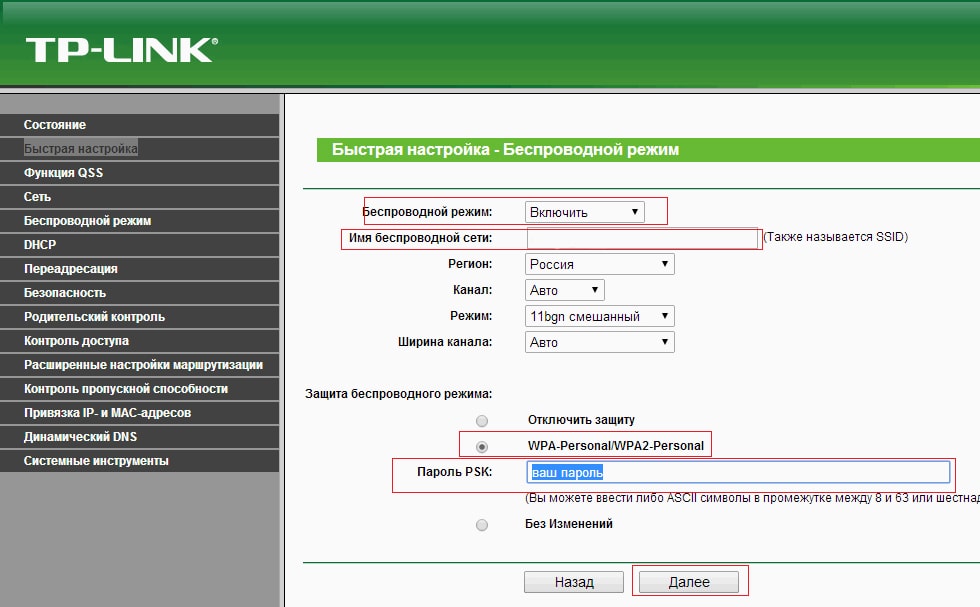
 Which is better iPhone 6s or 6 plus
Which is better iPhone 6s or 6 plus Where are screenshots and games in the Steam folder?
Where are screenshots and games in the Steam folder? How to delete or restore all deleted VKontakte dialogs at once?
How to delete or restore all deleted VKontakte dialogs at once?